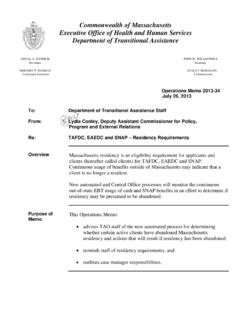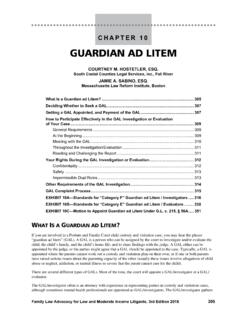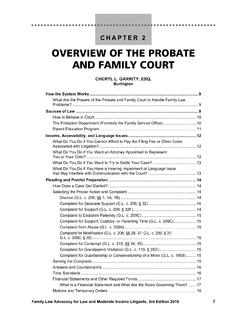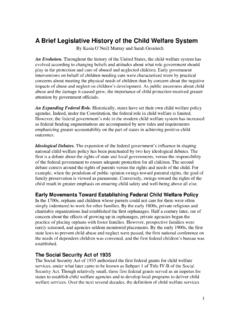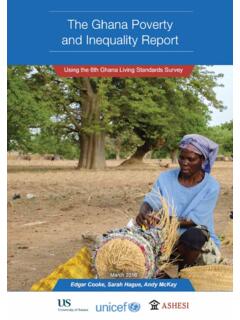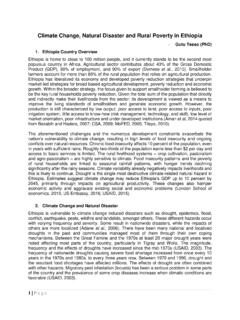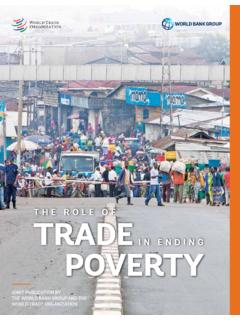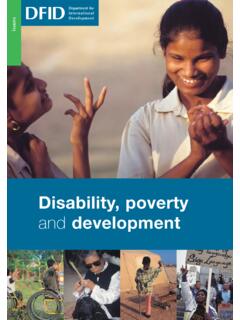Transcription of The Relationship between Poverty & Mass Incarceration
1 1 The Relationship between Poverty & Mass Incarceration How mass Incarceration contributes to Poverty in the United States Background Recent research indicates that, if not for the rise in Incarceration , the number of people in Poverty would fall by as much as 20 The economy more than doubled in the three decades prior to the Great Recession, but the Poverty rate remained largely unchanged. At the same time, Incarceration rates increased rapidly by 342%, from 111 to 491 for every 100,000 The rise of mass Incarceration did not result from an increase in crime trends, but from tough on crime policies such as stringent drug policies, stop-and-frisk, mandatory sentencing, and harsher treatment of parole violations.
2 These policies, among others, lead to a disproportionate impact for people of color. The United States has the highest rate of Incarceration in the world, with 730 prisoners for every 100,000 citizens, for a current total of more than million More than 60 percent of those in prison come from African American and Latino People who enter the criminal justice system are overwhelmingly poor. Two-thirds detained in jails report annual incomes under $12,000 prior to Incarceration contributes to Poverty by creating employment barriers; reducing earnings and decreasing economic security through criminal debt, fees and fines; making access to public benefits difficult or impossible; and disrupting communities where formerly incarcerated people reside.
3 Why mass Incarceration impedes Poverty reduction Imposes barriers to employment: A year after release, 60 percent of formerly incarcerated people remain Sixty-five million Americans 1 in 4 adults have a criminal record that may show up in a routine background check Research demonstrates that when matched pairs are given identical resumes, with the only difference being that one includes a criminal record, those with a record are much less likely to gain Results in reduced lifetime and intergenerational earnings: After the completion of their sentence, the wages of formerly incarcerated people may be limited by their Reduced earnings make both the present and future more economically precarious for formerly incarcerated people and their families.
4 2 Removes primary earners and drains assets of low-income : Incarceration of a family member may mean losing income from a primary earner and increased childcare expenses. Additionally, the criminal justice system and private companies drain assets from families who often financially support incarcerated loved ones and pay for phone calls,xi basic goods, and sentencing and prison fees and Limits access to public benefits: People with certain types of criminal records encounter roadblocks and in some cases are completely barred from receiving cash assistance, SNAP (food stamps)xiii and housing Research shows that benefits such as SNAP effectively reduce Poverty and support working Disrupts the social and economic fabric of neighborhoods.
5 Incarceration affects neighborhoods by breaking up families, weakening financial health and purchasing power, and discouraging These disruptions deepen the layers of inequality in a geographic area. These factors support reducing Poverty by addressing consequences of mass Incarceration . Also, while it appears policies that drive mass Incarceration are changing and may lead to lower levels of Incarceration , the path toward reasonable policies remains uncertain. Whatever the future holds, there are currently millions of people in prison or who have returned to their communities. They are now living with severe consequences as they attempt to support themselves and their families.
6 Fair hiring practices, protection from discrimination, and access to public benefits are just a few of the many potential policy solutions that would address the needs of formerly incarcerated people and support efforts to significantly reduce Poverty . i DeFina, R. & Hannon, L. 2013. The Impact of Mass Incarceration on Poverty . Crime & Delinquency, 59, 562-586 ii DeFina, R. & Hannon, L. 2013. The Impact of Mass Incarceration on Poverty . Crime & Delinquency, 59, 562-586 iii Jones, S. & Mauer, M. 2013. Race to Incarceration . New York: The New Press iv The Sentencing Project.
7 Racial Disparity. (2010). Retrieved from v Alexander, M. The New Jim Crow. (2012). New York, NY: The New Press vi Vallas, R. & Dietrich, S. Criminal Debt: A barrier to reentry and climbing out of Poverty . Retrieved from online webinar presentation: vii Rodriguez, M. N. & Emsellem, M. (March 2011). 65 Million Need Not Apply The Case for Reforming Criminal Background Checks for Employment. Retrieved from viii Pager, D. (March 2003). The Mark of a Criminal Record. American Journal of Sociology, 108. Retrieved from ~ ix Gudrais, E. (2013, March-April). The Prison Problem. Harvard Magazine. Retrieved from x DeFina, R. & Hannon, L.
8 2013. The Impact of Mass Incarceration on Poverty . Crime & Delinquency, 59, 562-586 xi Kukorowski, D. Wagner, P., & Sakala, L. Please Deposit All of Your Money: Kickbacks, rates, and hidden fees in the jail phone industry. (May 2013). Retrieved from xii Bannon, A., Nagrecha, M., & Diller, R. Criminal Justice Debt: A barrier to reentry. (2010). Retrieved from 3 xiii Legal Action Center. Opting Out of the Federal Ban on Food Stamps and TANF. Retrieved from xiv Legal Action Center. Improving Housing Opportunities for People with Criminal Records.
9 Retrieved from xv Sherman, A., Trisi, D., & Parrot, S. Various Supports for Low-Income Families Reduce Poverty and Have Long-Term Positive Effects on Families and Children. Retrieved from xvi DeFina, R. & Hannon, L. 2013. The Impact of Mass Incarceration on Poverty . Crime & Delinquency, 59, 562-586

